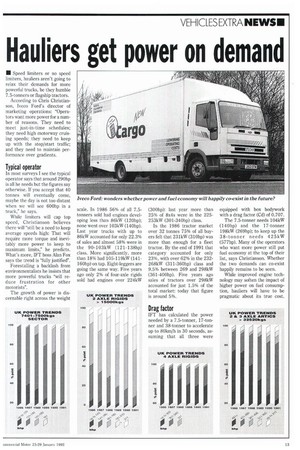Hauliers get power on demand
Page 15

If you've noticed an error in this article please click here to report it so we can fix it.
• Speed limiters or no speed limiters, hauliers aren't going to relax their demands for more powerful trucks, be they humble 7.5-tonners or flagship tractors.
According to Chris Christianson, Iveco Ford's director of marketing operations: "Operators want more power for a number of reasons. They need to meet just-in-time schedules; they need high motorway cruising speeds; they need to keep up with the stop/start traffic; and they need to maintain performance over gradients.
Typical operator
In most surveys I see the typical operator says that around 290hp is all he needs but the figures say otherwise. If you accept that 40 tonnes will eventually come, maybe the day is not too distant when we will see 600hp in a truck," he says.
While limiters will cap top speed, Christianson believes there will "still be a need to keep average speeds high: That will require more torque and inevitably more power to keep to maximum limits," he predicts. What's more, IFT boss Alan Fox says the trend is "fully justified".
Forestalling a backlash from environmentalists he insists that more powerful trucks "will reduce frustration for other motorists".
The growth of power is discernable right across the weight scale. In 1986 56% of all 7.5tonners sold had engines developing less than 86kW (120hp); none went over 103kW (140hp). Last year trucks with up to 86kW accounted for only 22.3% of sales and almost 58% were in the 90-103kW (121-138hp) class. More significantly, more than 18% had 105-119kW (141160hp) on tap. Eight-leggers are going the same way. Five years ago only 2% of four-axle rigids sold had engines over 224kW (300hp): last year more than 25% of 8x4s were in the 225253kW (301-340hp) class.
In the 1986 tractor market over 32 tonnes 75% of all buyers felt that 231kW (310hp) was more than enough for a fleet tractor. By the end of 1991 that category accounted for only 23%, with over 62% in the 232268kW (311-360hp) class and 9.5% between 269 and 298kW (361-400hp). Five years ago sales of tractors over 298kW accounted for just 1.5% of the total market: today that figure is around 5%. equipped with box bodywork with a drag factor (Cd) of 0107.
The 7.5-tonner needs 104kW (140hp) and the 17-tanner 198kW (269hp); to keep up the 38-tonner needs 425kW (577hp). Many of the operators who want more power still put fuel economy at the top of their list, says Christianson. Whether the two demands can co-exist happily remains to be seen.
While improved engine technology may soften the impact of higher power on fuel consumption, hauliers will have to be pragmatic about its true cost.
































































































































































